Controlling the Wetting Properties of Superhydrophobic Titanium Surface Fabricated by UV Nanosecond-Pulsed Laser and Heat Treatment
Abstract
1. Introduction
2. Materials and Methods
3. Results
3.1. Surface Morphology
3.2. Wettability
4. Discussion
4.1. Mechanism
4.2. Effects of Laser Power and Step Size on Wettablity
4.3. Stability
5. Conclusions
Supplementary Materials
Author Contributions
Funding
Conflicts of Interest
References
- Yao, X.; Song, Y.; Jiang, L. Applications of bio-inspired special wettable surfaces. Adv. Mater. 2011, 23, 719–734. [Google Scholar] [CrossRef] [PubMed]
- Sas, I.; Gorga, R.E.; Joines, J.A.; Thoney, K.A. Literature review on superhydrophobic self-cleaning surfaces produced by electrospinning. J. Polym. Sci. Part B Polym. Phys. 2012, 50, 824–845. [Google Scholar] [CrossRef]
- Onda, T.; Shibuichi, S.; Satoh, N.; Tsujii, K. Super-water-repellent fractal surfaces. Langmuir 1996, 12, 2125–2127. [Google Scholar] [CrossRef]
- Wahab, J.A.; Ghazali, M.J.; Yusoff, W.M.W.; Sajuri, Z. Enhancing material performance through laser surface texturing: A review. Trans. IMF 2016, 94, 193–198. [Google Scholar] [CrossRef]
- Lutey, A.H.A.; Gemini, L.; Romoli, L.; Lazzini, G.; Fuso, F.; Faucon, M.; Kling, R. Towards laser-textured antibacterial surfaces. Sci. Rep. 2018, 8, 1–10. [Google Scholar] [CrossRef] [PubMed]
- Yu, D.; Tian, J. Superhydrophobicity: Is it really better than hydrophobicity on anti-corrosion? Colloids Surf. A Physicochem. Eng. Asp. 2014, 445, 75–78. [Google Scholar] [CrossRef]
- Tang, Y.; Zhang, Q.; Zhan, X.; Chen, F. Superhydrophobic and anti-icing properties at overcooled temperature of a fluorinated hybrid surface prepared via a sol–gel process. Soft Matter 2015, 11, 4540–4550. [Google Scholar] [CrossRef] [PubMed]
- Lee, J.P.; Choi, S.; Park, S. Extremely superhydrophobic surfaces with micro- and nanostructures fabricated by copper catalytic etching. Langmuir 2011, 27, 809–814. [Google Scholar] [CrossRef] [PubMed]
- Ganesh, V.A.; Raut, H.K.; Nair, A.S.; Ramakrishna, S. A review on self-cleaning coatings. J. Mater. Chem. 2011, 21, 16304. [Google Scholar] [CrossRef]
- Yang, C.J.; Mei, X.S.; Tian, Y.L.; Zhang, D.W.; Li, Y.; Liu, X.P. Modification of wettability property of titanium by laser texturing. Int. J. Adv. Manuf. Technol. 2016, 87, 1663–1670. [Google Scholar] [CrossRef]
- Kwak, G.; Seol, M.; Tak, Y.; Yong, K. Superhydrophobic ZnO nanowire surface: Chemical modification and effects of UV irradiation. J. Phys. Chem. C 2009, 113, 12085–12089. [Google Scholar] [CrossRef]
- Etsion, I. State of the art in laser surface texturing. J. Tribol. 2005, 127, 248. [Google Scholar] [CrossRef]
- Riveiro, A.; Maçon, A.L.B.; del Val, J.; Comesaña, R.; Pou, J. Laser surface texturing of polymers for biomedical applications. Front. Phys. 2018, 6, 16. [Google Scholar] [CrossRef]
- Yilbas, B.S.; Khaled, M.; Abu-Dheir, N.; Aqeeli, N.; Furquan, S.Z. Laser texturing of alumina surface for improved hydrophobicity. Appl. Surf. Sci. 2013, 286, 161–170. [Google Scholar] [CrossRef]
- Jiang, T.; Koch, J.; Unger, C.; Fadeeva, E.; Koroleva, A.; Zhao, Q.; Chichkov, B.N. Ultrashort picosecond laser processing of micro-molds for fabricating plastic parts with superhydrophobic surfaces. Appl. Phys. A Mater. Sci. Process. 2012, 108, 863–869. [Google Scholar] [CrossRef]
- Wang, D.; Wang, X.; Liu, X.; Zhou, F. Engineering a titanium surface with controllable oleophobicity and switchable oil adhesion. J. Phys. Chem. C 2010, 114, 9938–9944. [Google Scholar] [CrossRef]
- Chun, D.M.; Ngo, C.V.; Lee, K.M. Fast fabrication of superhydrophobic metallic surface using nanosecond laser texturing and low-temperature annealing. CIRP Ann. Manuf. Technol. 2016, 65, 519–522. [Google Scholar] [CrossRef]
- Ngo, C.V.; Chun, D.M. Effect of heat treatment temperature on the wettability transition from hydrophilic to superhydrophobic on laser-ablated metallic surfaces. Adv. Eng. Mater. 2018, 1701086, 1–11. [Google Scholar] [CrossRef]
- Ngo, C.-V.; Chun, D.-M. Fast wettability transition from hydrophilic to superhydrophobic laser-textured stainless steel surfaces under low-temperature annealing. Appl. Surf. Sci. 2017, 409, 232–240. [Google Scholar] [CrossRef]
- Wu, S.Z.; Wang, J.N.; Niu, L.G.; Yao, J.; Wu, D.; Li, A.W. Reversible switching between isotropic and anisotropic wetting by one-direction curvature tuning on flexible superhydrophobic surfaces. Appl. Phys. Lett. 2011, 98, 8–10. [Google Scholar] [CrossRef]
- Moradi, S.; Hadjesfandiari, N.; Toosi, S.F.; Kizhakkedathu, J.N.; Hatzikiriakos, S.G. Effect of extreme wettability on platelet adhesion on metallic implants: From superhydrophilicity to superhydrophobicity. ACS Appl. Mater. Interfaces 2016, 8, 17631–17641. [Google Scholar] [CrossRef] [PubMed]
- Ngo, C.-V.; Chun, D.-M. Control of laser-ablated aluminum surface wettability to superhydrophobic or superhydrophilic through simple heat treatment or water boiling post-processing. Appl. Surf. Sci. 2018, 435, 974–982. [Google Scholar] [CrossRef]


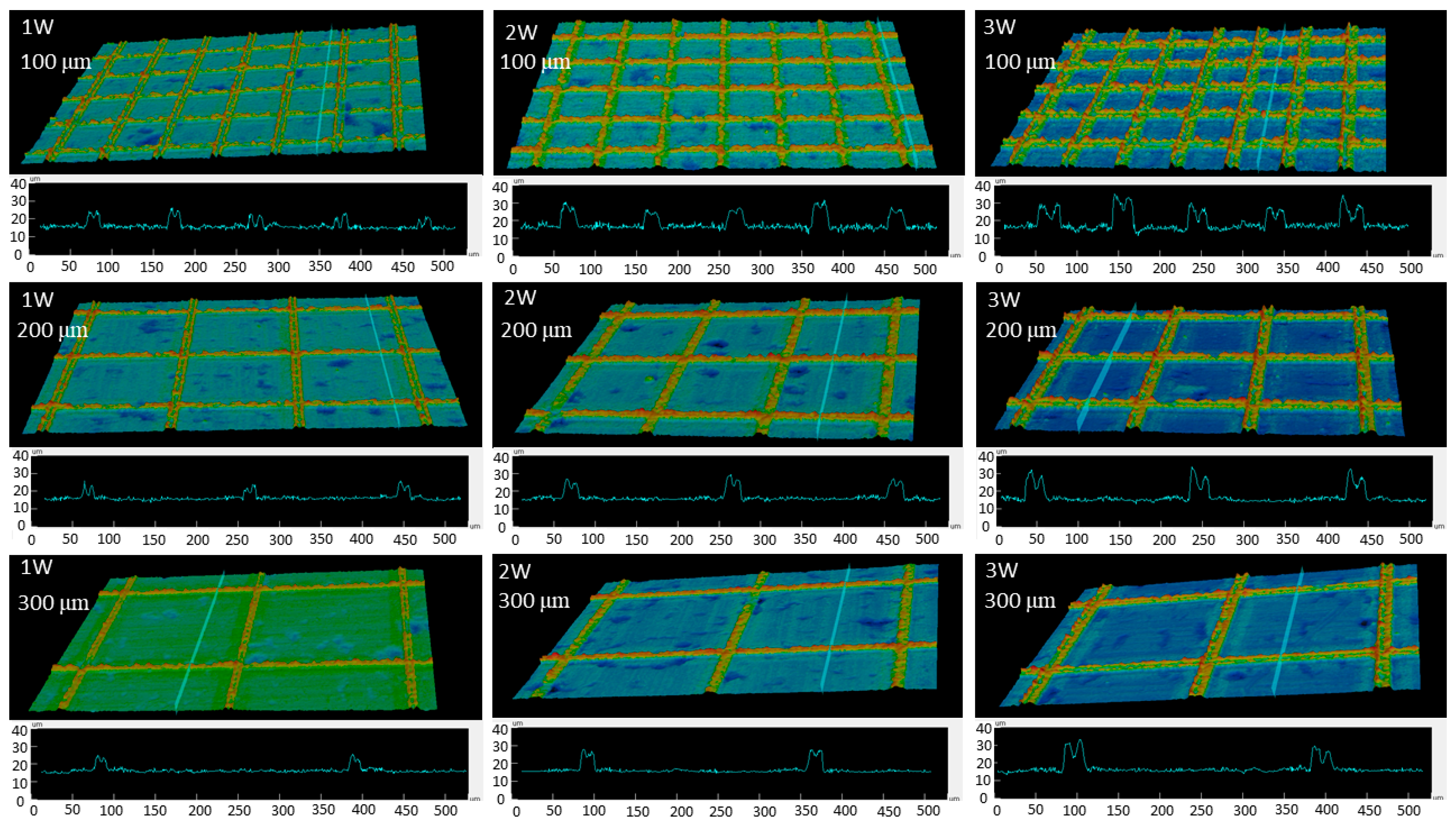


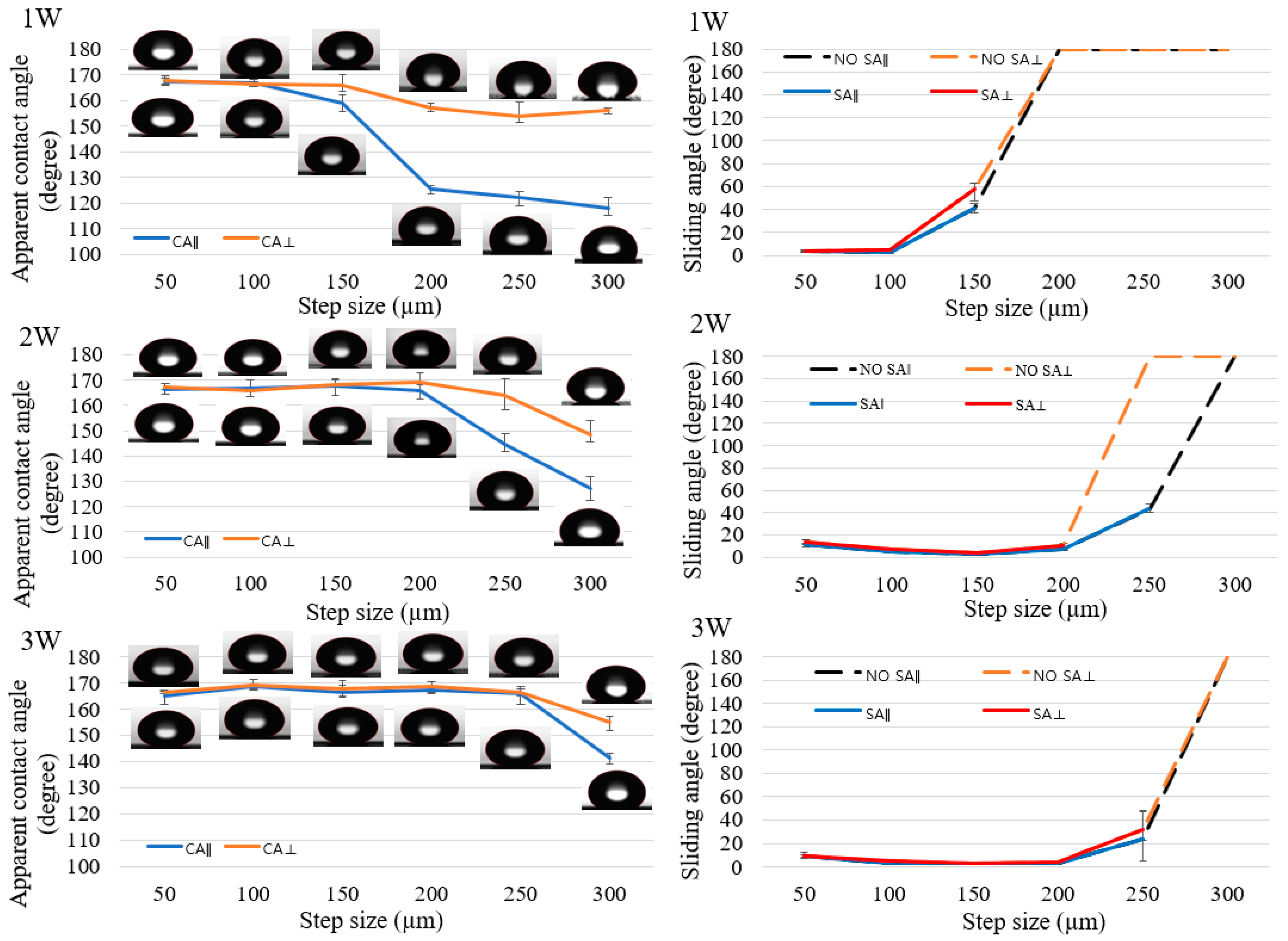
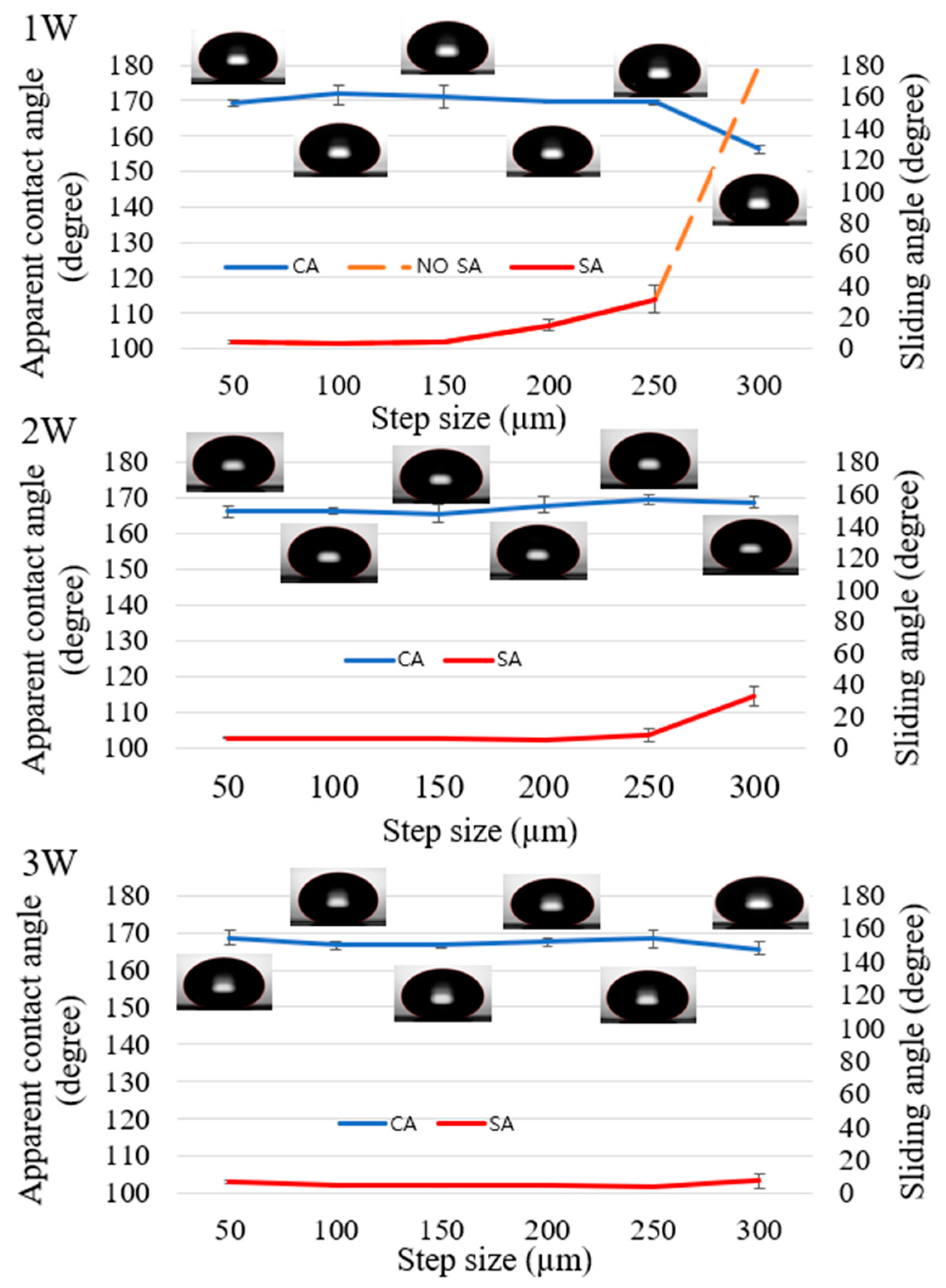
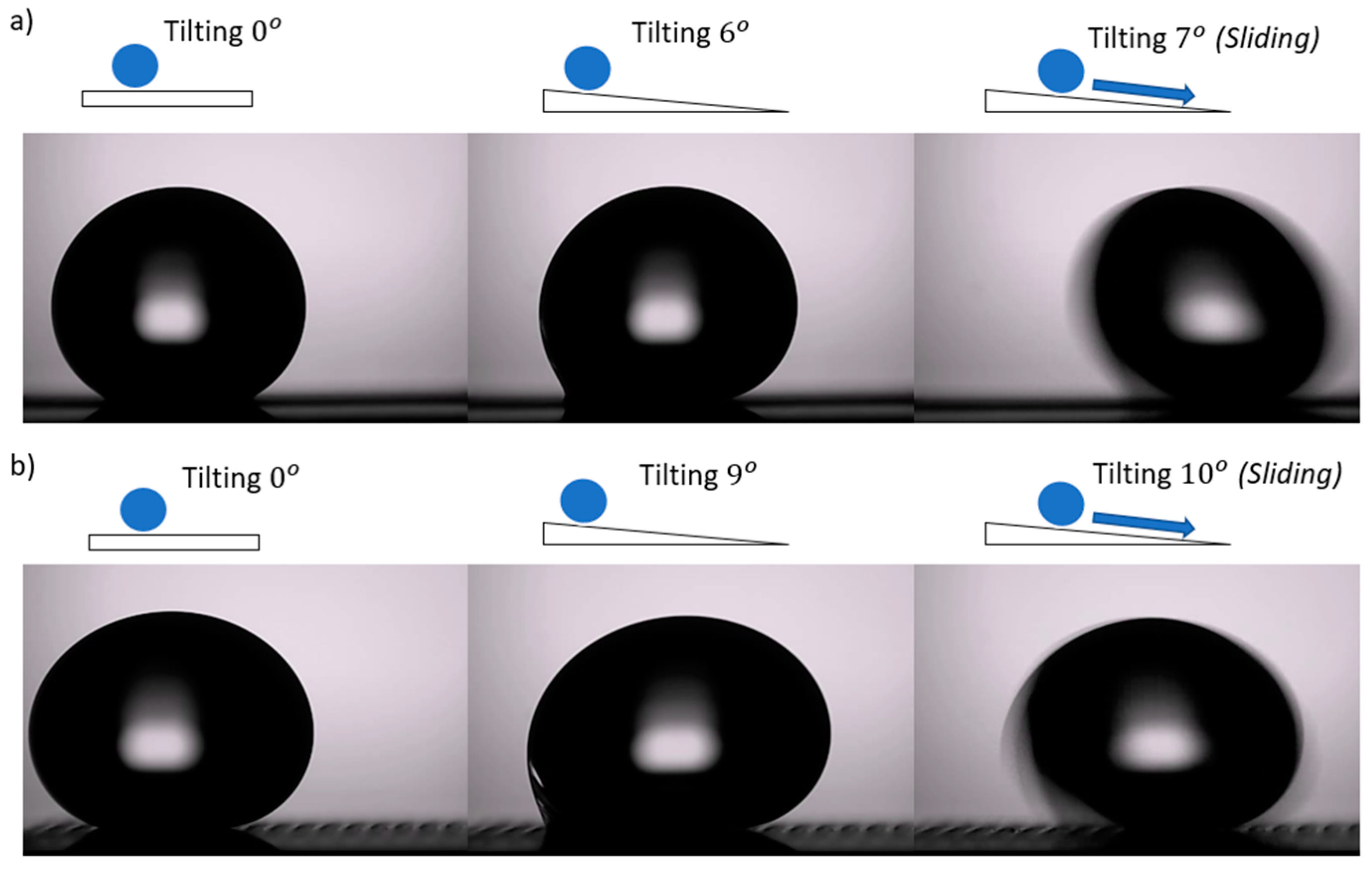
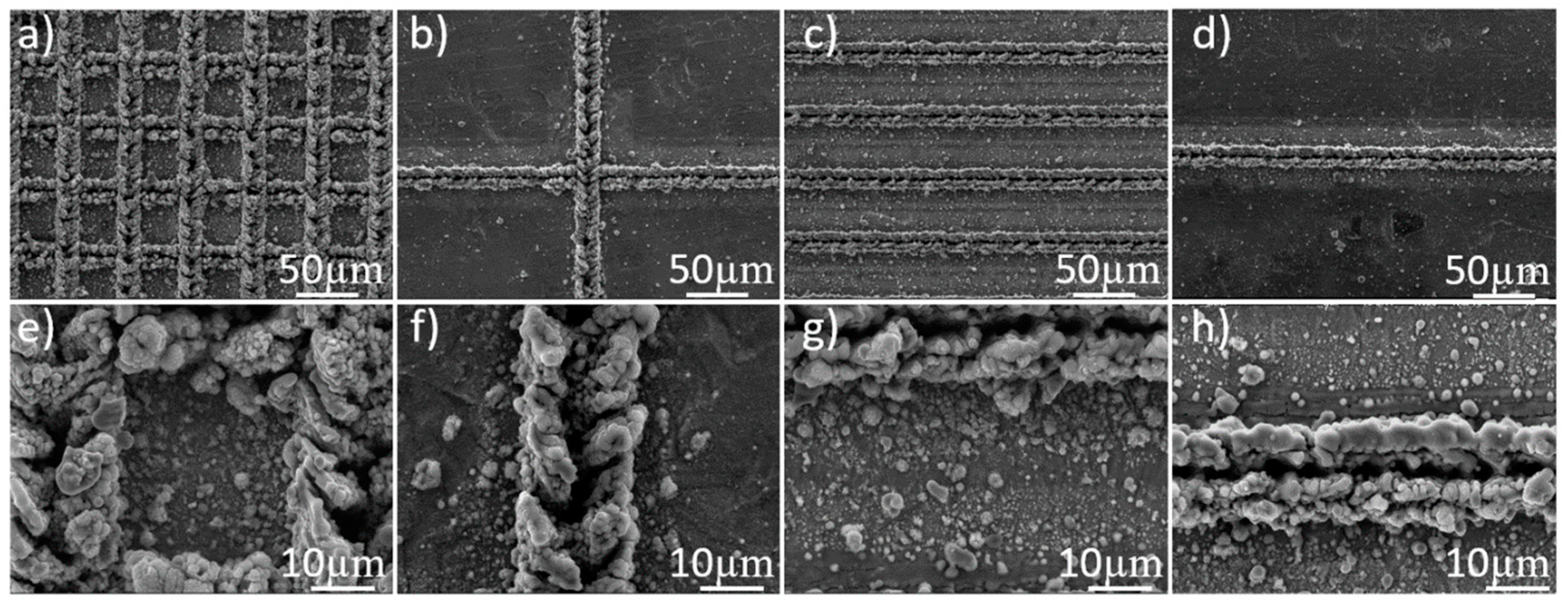
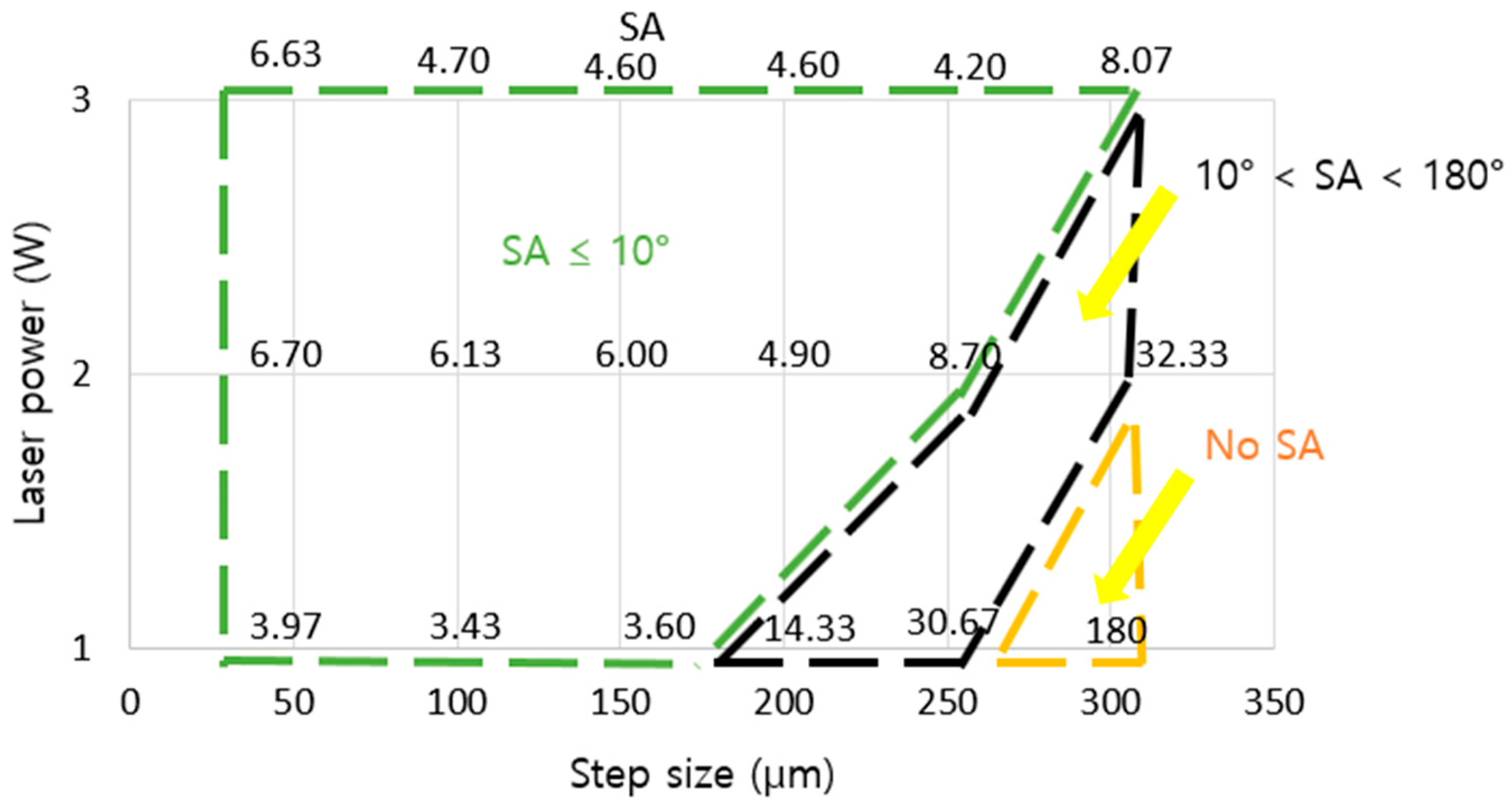
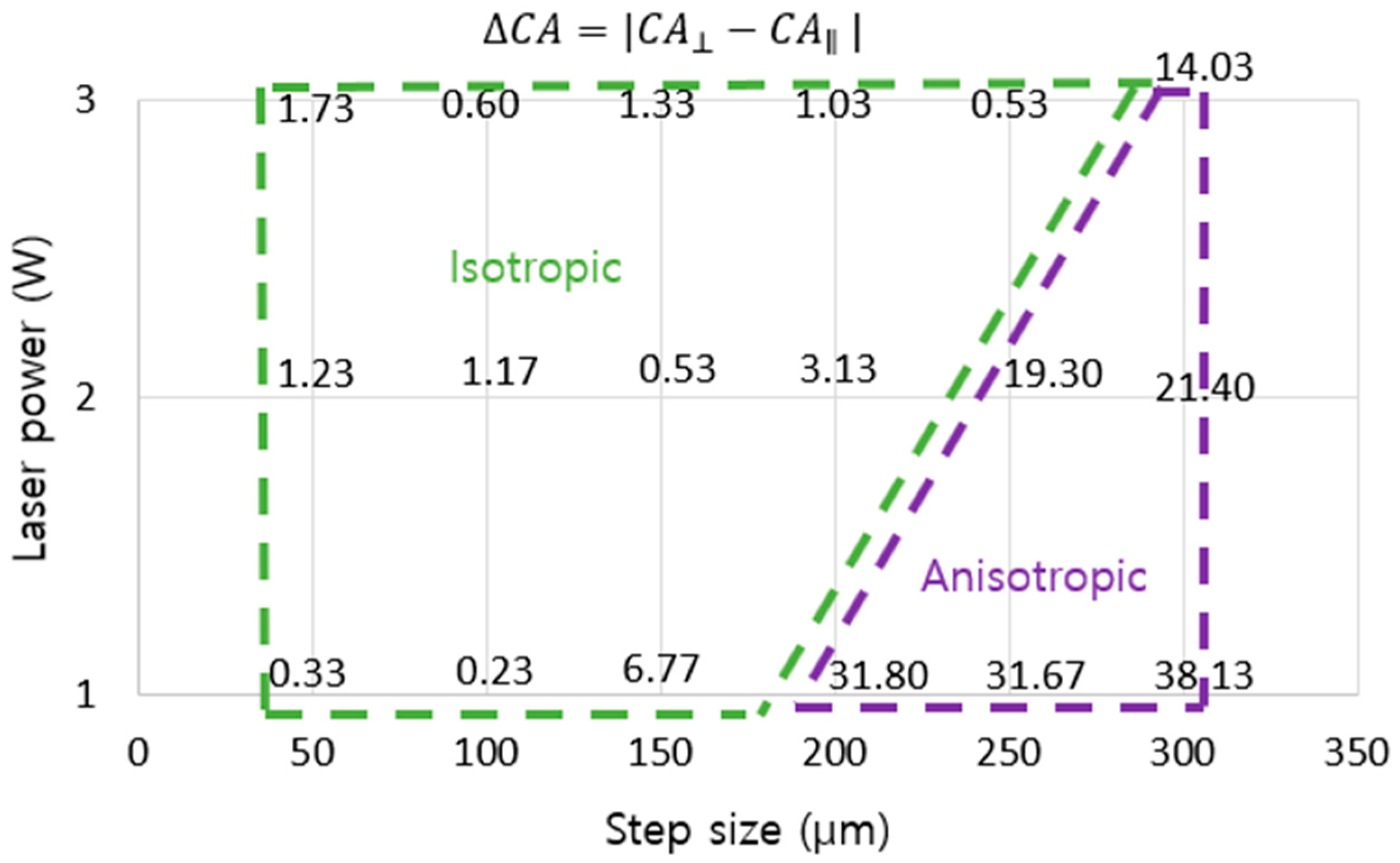
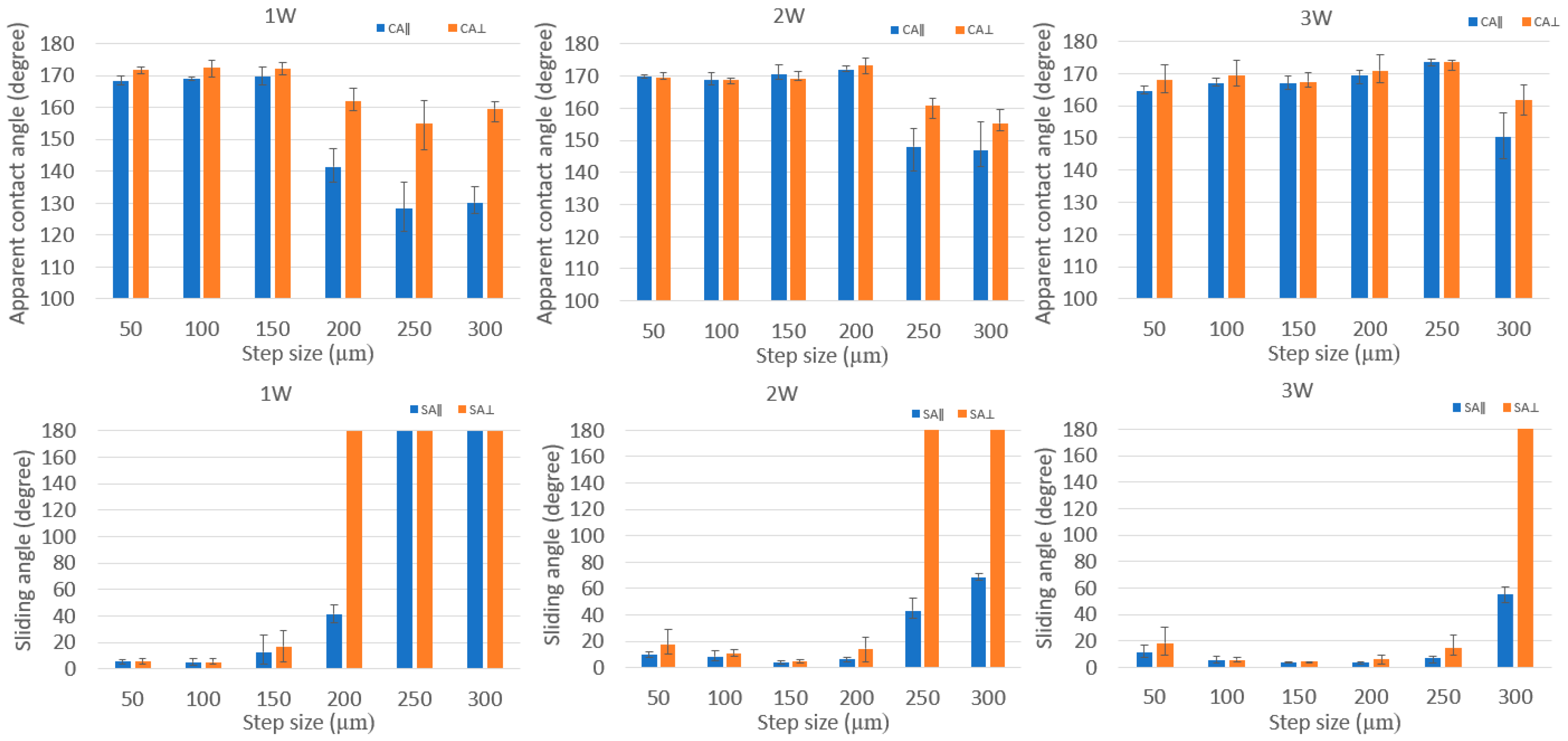
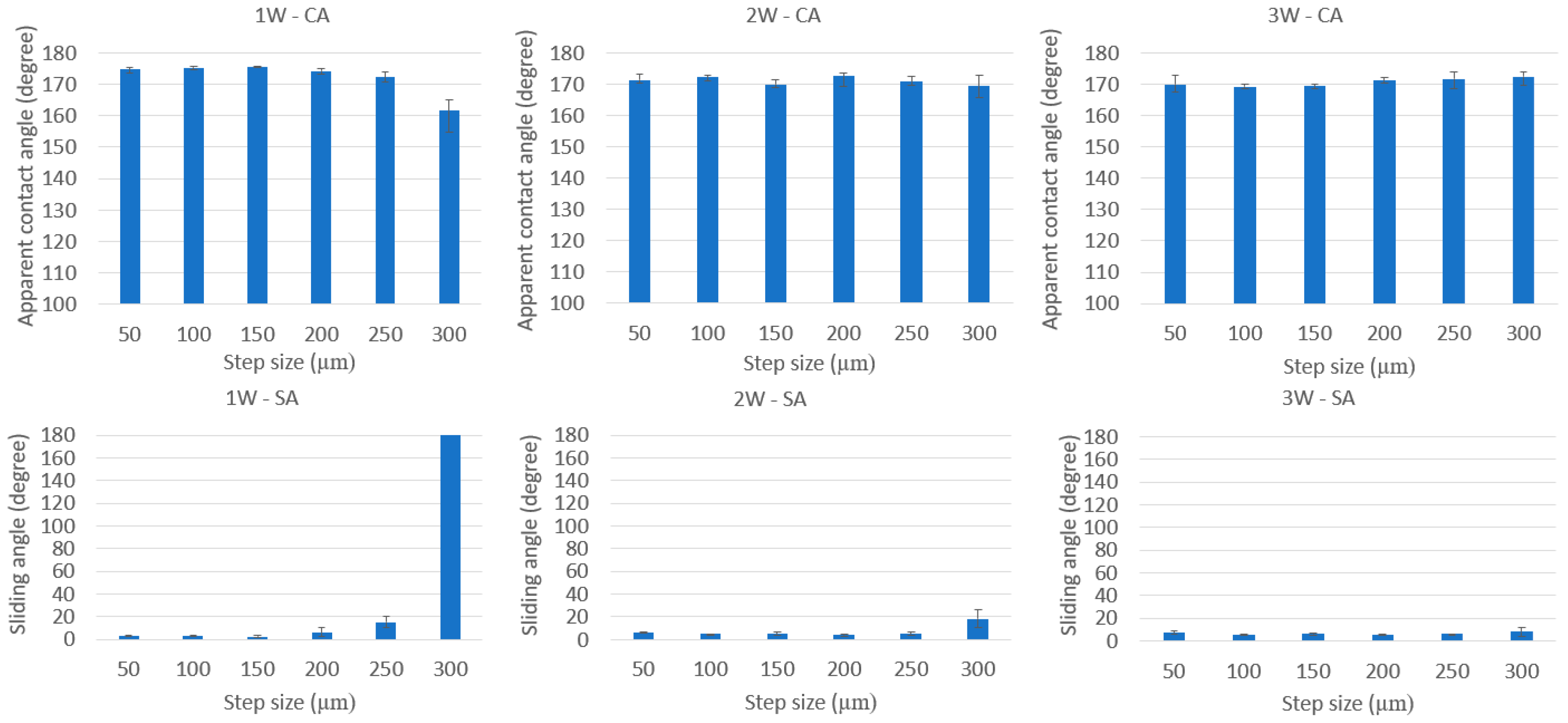
| Name of Parameter | Value |
|---|---|
| Power (W) | 1, 2, 3 |
| Pulse frequency (kHz) | 20 |
| Pulse duration (ns) | 20 |
| Stage speed (mm/s) | 1 |
| Step size (μm) | 50, 100, 150, 200, 250, 300 |
| Element (Atomic %) | Line Pattern | Grid Pattern | ||||||
|---|---|---|---|---|---|---|---|---|
| Step Size 50 μm | Step Size 300 μm | Step Size 50 μm | Step Size 300 μm | |||||
| Before | After | Before | After | Before | After | Before | After | |
| C | 6.51 | 7.33 | 6.43 | 9.35 | 5.67 | 7.6 | 7.33 | 8.35 |
| O | 68.26 | 68.51 | 47.95 | 64.52 | 62.96 | 63.62 | 56.95 | 65.94 |
| Ti | 25.23 | 24.16 | 45.62 | 26.12 | 31.37 | 28.79 | 35.72 | 25.71 |
| C/Ti | 0.26 | 0.30 | 0.14 | 0.36 | 0.18 | 0.31 | 0.16 | 0.32 |
| O/Ti | 2.71 | 2.84 | 1.05 | 2.47 | 2.01 | 2.63 | 1.25 | 2.52 |
© 2018 by the authors. Licensee MDPI, Basel, Switzerland. This article is an open access article distributed under the terms and conditions of the Creative Commons Attribution (CC BY) license (http://creativecommons.org/licenses/by/4.0/).
Share and Cite
Dinh, T.-H.; Ngo, C.-V.; Chun, D.-M. Controlling the Wetting Properties of Superhydrophobic Titanium Surface Fabricated by UV Nanosecond-Pulsed Laser and Heat Treatment. Nanomaterials 2018, 8, 766. https://doi.org/10.3390/nano8100766
Dinh T-H, Ngo C-V, Chun D-M. Controlling the Wetting Properties of Superhydrophobic Titanium Surface Fabricated by UV Nanosecond-Pulsed Laser and Heat Treatment. Nanomaterials. 2018; 8(10):766. https://doi.org/10.3390/nano8100766
Chicago/Turabian StyleDinh, The-Hung, Chi-Vinh Ngo, and Doo-Man Chun. 2018. "Controlling the Wetting Properties of Superhydrophobic Titanium Surface Fabricated by UV Nanosecond-Pulsed Laser and Heat Treatment" Nanomaterials 8, no. 10: 766. https://doi.org/10.3390/nano8100766
APA StyleDinh, T.-H., Ngo, C.-V., & Chun, D.-M. (2018). Controlling the Wetting Properties of Superhydrophobic Titanium Surface Fabricated by UV Nanosecond-Pulsed Laser and Heat Treatment. Nanomaterials, 8(10), 766. https://doi.org/10.3390/nano8100766







